Aztecs
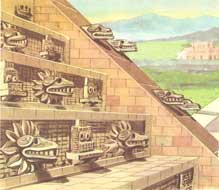
Atop a high pyramid stood the Great Temple to the war god, Huitzilopochtli, dominating Temple Square in the Aztec capital.
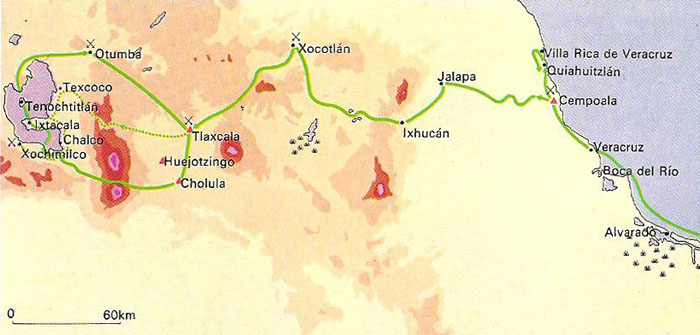
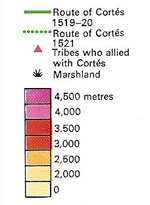 Cortés
landed at Veracruz on 22 April 1519. By forming alliances with the
peoples of Cempoala, Jalapa, and Tlaxcala, he maintained his supply
line with the coast. After some skirmishes, he persuaded the powerful
independent "state" of Tlaxacala to join him, thus obtaining the much-needed
base from which to launch his attack on the Aztec capital of Tenochtitlán.
After the retreat of the "Sorrowful Night" on 30 June 1520, Cortés
fled to Tlaxcala. With the help of local workmen he built a fleet
of brigantines to harass the defenders of Tenochtitlán from
the lake. These were carried in pieces and assembled on the lake shore,
while the army, composed largely of Tlaxcalans, attacked the towns
that were sympathetic to the beleaguered Aztecs.
Cortés
landed at Veracruz on 22 April 1519. By forming alliances with the
peoples of Cempoala, Jalapa, and Tlaxcala, he maintained his supply
line with the coast. After some skirmishes, he persuaded the powerful
independent "state" of Tlaxacala to join him, thus obtaining the much-needed
base from which to launch his attack on the Aztec capital of Tenochtitlán.
After the retreat of the "Sorrowful Night" on 30 June 1520, Cortés
fled to Tlaxcala. With the help of local workmen he built a fleet
of brigantines to harass the defenders of Tenochtitlán from
the lake. These were carried in pieces and assembled on the lake shore,
while the army, composed largely of Tlaxcalans, attacked the towns
that were sympathetic to the beleaguered Aztecs.
Before the arrival of the Europeans the Aztecs of Mexico under their last emperor Montezuma II had developed the most advanced indigenous civilization ever seen on the American continent. The native tribes in North America (present-day Canada and the US) were then nomads. Their homes were wigwams; they dressed in skins and lived by hunting and fishing. In contrast the Aztecs wore garments of cotton cloth and sandals of fiber. They had beautiful ornaments made of gold, silver, and jade (which was considered more precious than gold). Many of them lived in fine cities with houses of stone and gardens where they grew flowers for their gods. Moreover they understood the art of farming and planted regular crops of corn, which was their staple food. Also their artisans knew how to fuse metals and make tools and knives of a obsidian (a black volcanic glass). The goldsmiths and silversmiths had great skill and fashioned original and beautiful ornaments.
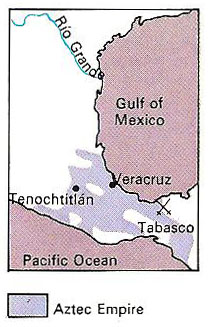 |
Montezuma lived in an extravagant palace that had hundreds of rooms (many with baths). Water inside the palace came from the same source as the fountains in the courtyards. There was also a fine botanical gardens, a zoo, and an aviary containing hundreds of exotic birds gathered from every part of Mexico. From their feathers the women of the Court made fairy-like mantles of feather-work, embroidered over a thin cotton webbing. The Emperor also wore these shimmering garments, as did his nobles.
The Aztecs lived in an organized society; they had a parliament, a nobility, a religious order, and a Legion of Honor for the bravest warriors: the Eagle and the Tiger Knights.
Tenochtitlán
The brilliant Aztec capital was called Tenochtitlán, meaning "Cactus-on-Stone". This referred to the founding of their capital on the border of a great salt lake called Texcoco in 1325. For several hundred years they had wandered in search of three symbols, which an oracle had foretold would show them where to found their city. On reaching the valley of Mexico, the Aztecs saw a royal eagle, gripping a serpent in its talons, as it perched on a cactus growing out of stone – the prophesied tokens.
When Hernán Cortés came to Mexico (see below) in 1521, Tenochtitlan was a city with about 100,000 inhabitants. Canals flowed between its houses, which were built on islands and on piles driven into the bed of the lake. There were forty temples built in honor of the god Huitzilopochtli and of his brother Texcatlipoca.
The Aztec Empire
In later years the Aztecs conquered provinces lying far outside the Valley of Mexico. The Aztec Empire consisted of a loose federation on conquered indian states. They kept their own particular language, customs, and chiefs, but paid the Aztecs a yearly tribute. The tax-collectors used to bring back strange and valuable things: sacks of turquoise and coral beads, bundles of beautiful feathers of tropical birds, sacks of cocoa beans for the Emperor's royal drink, gold and silver necklaces, bracelets, earrings, and brooches.
The beginnings of Spanish colonization in the New World
The colonization of the New World began after Christopher Columbus returned from his historic voyages. At the turn of the 15th and 16th centuries, two European countries prevailed in overseas expansion: Portugal and Spain. The Portuguese focused their attention on the coast South America (as well as that of Africa), whereas the Spanish headed for Central America. Colonization in itself, exploitation of natural resources, and the spread of Christianity were the main goals.
The Spanish conquest of the New World began in the Caribbean, with the islands of Hispaniola, Jamaica, Tortuga, and, the largest of them all, Cuba. The mineral resources of these islands, however, proved to be slender and, despite the name Golden Castile, the area had little to offer. From Cuba, the main base for the Spanish explorers, trading expeditions were launched to gather information about the Yucatán coast of Mexico (its terrain, the possibility of mooring, and the best locations to establish a permanent settlement) and its inhabitants (their attitude toward the Spaniards and the possibility of trade.) These expeditions revealed the likelihood of greater wealth in the interior.
In 1519, after two preliminary expeditions, the governor of Cuba, Diego Velázquez de Cuéllar (c. 1460–c. 1542), sent a fleet under Cortés to settle the region.
Cortés versus Montezuma II
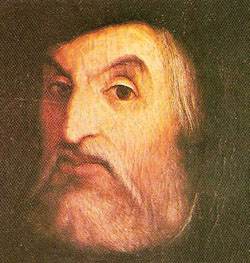 |
| Hernán Cortés was born in the province
of Estremadura in Spain. He sailed for Hispaniola in 1504 and as Velázquez's
lieutenant, he took part in the conquest of Cuba. His career subsequent
to the conquest of Mexico was, like that of so many conquistadores,
spent largely in an effort to secure from the crown due recognition
of his achievements.
|
Hernán Cortés (1485–1547) and his expedition of 550 men landed on the coast of Mexico and founded the settlement of Veracruz. Cortés then threw over Velázquez's authority and placed himself directly under the Spanish crown. He learned about the nature of the Aztec Empire – that it wasn't a monolith but a net of alliances, marked by mutual hostility and dependency. By a series of adroit diplomatic moves and superior military technology, Cortés took formal possession of Tenochtitlán. Before this happened Montezuma offered gifts to try to placate the invaders, but this had an opposite effect to what the emperor intended and only served to encourage the Spanish to moved deeper into his empire. On 8 November 1519, Cortés met Montezuma along with some other important political figures of the Empire. The Spaniards were invited to the palace of Montezuma's father – an important political gesture. The palace was a symbol of political power and the importance of its owner. The biggest palaces were surrounded by botanic gardens, which were places to relax and the center of a palace's social life.
But Cortés was aware of a danger. He and his men were in the capital of potentially hostile Empire. Most of his troops were outside Tenochtitlán. In order to take control of the situation, the Spaniards arrested Montezuma. Gradually tensions rose between the Spaniards and Tenochtitlán's inhabitants.
Cortés learned that Spanish forces had landed with the aim of arresting him because of his illegal expedition. With some of his men Cortés left the city, intercepted and defeated the forces sent to arrest him, and then returned to the city to find that the situation had deteriorated there. Fights had broken out between the Aztecs and the Spaniards after Cortés had left Tenochtitlán.
In order to calm the Aztecs down the Spaniards used Montezuma. But the Aztecs then considered him to be a Spanish puppet and he was killed by his own people. To to save themselves the Spaniards fled the capital.
The original plan to take control of the Aztec Empire by controlling its capital and failed. So the Spaniards changed their strategy, and laid siege to the city instead, cutting off its supplies and its sources of fresh water. Now it was only a matter of time before Tenochtitlán fell. All tribes loyal to Tenochtitlán were conquered. The more successful the Spaniards were, the more allies they gained. Tenochtitlán's vassals wanted revenge and sided with the Spaniards. As food stockpiles and other goods ran out, a new threat appeared an epidemic of smallpox epidemic. In the end, this disease spelled doom for the Empire.
The final stage of conquest took place in Tenochtitlán and involved bloody fights. Defenders didn't want to become slaves and fought to the death to defend their once powerful city-state. Finally, in August 1521 the city fell to the invaders. Temples, offices, and homesteads were destroyed and Tenochtitlán's inhabitants fled. Following this first regular military campaign between the Old and New World, a new political reality dawned on Mexico.
The old cultural ways and religion of the Aztec people were banned. Consumption of alcohol was allowed for the first time, leading to widespread alcoholism. Some of the Aztec nobility converted to Christianity. Fortunately not everything was lost the old Mexican language (Náhuatl) survived, and is still in use in many places in Mexico.
The conquest of the Aztec Empire (and later of the Mayans and the Inca) influenced the Spanish too. Huge amounts of gold and silver, together with local craft products and new kinds of plants, were transported by ships to European markets. Many now familiar food-items originate with the Aztecs and other Pre-Columbian cultures. These include tomatoes, potatoes, pumpkins, paprika, chocolate (cacao beans), and tortillas.
Decades after the Aztec Empire had fallen European powers began a race for global domination. The United Kingdom, France, the Netherlands, Belgium, and Germany all built empires around the world. Today these empires are part of history, but their languages remain in many countries, notably English, Spanish, and French. If we look at the lingual map of the Latin America, the effects of empire-building are obvious. From the Rio Grande River to the Drake Passage people speak Spanish and/or its local dialects. In the largest country in the region, Brazil, people use the language of the former colonial power: Portuguese. Exceptions to the Spanish-Portuguese domination are Belize and Guyana (English), French Guiana (French), and Suriname (Dutch).
Three centuries after the Coquistadors passed before Mexico, along with other countries of Latin America, became independent.
Why did the Aztecs lose?
The difference in technological level between the Spaniards and Aztecs was a basic reason the latter's downfall. But the Aztecs themselves were also responsible for their defeat. In order to obtain captives for their bloody religious rituals the Aztecs were almost constantly at war with their neighbors. No wonder these neighbors were ready to ally with anybody stronger than the Aztecs. The Spaniards used this situation to their advantage, presenting themselves as liberators from Aztec domination. The Spaniards used their new-found allies as porters, guards, patrol forces, spies – and cannon fodder. Finally, an epidemic of smallpox proved disastrous for the Aztecs.
